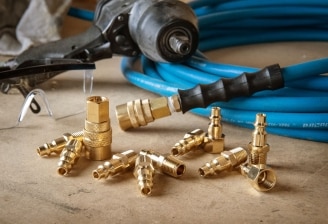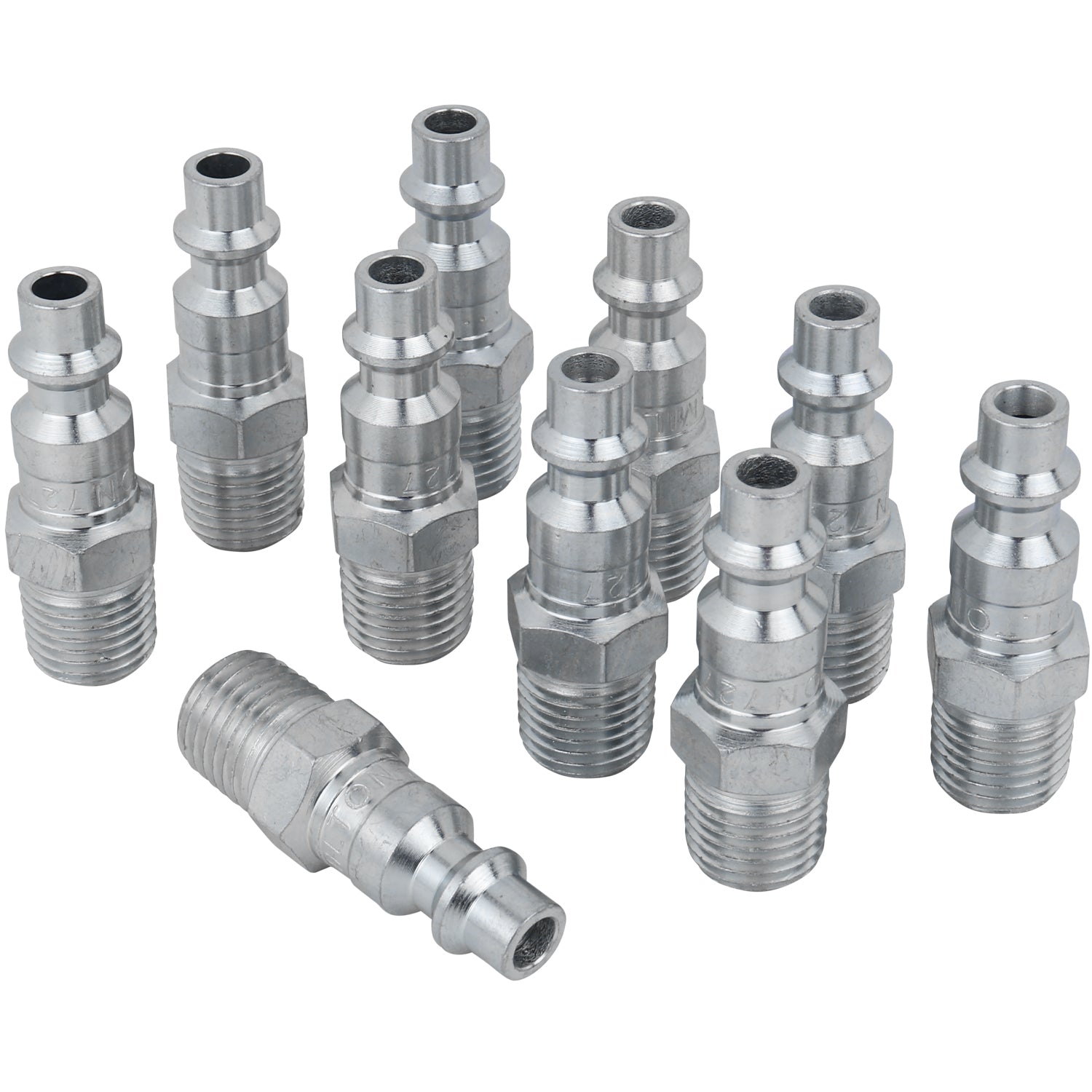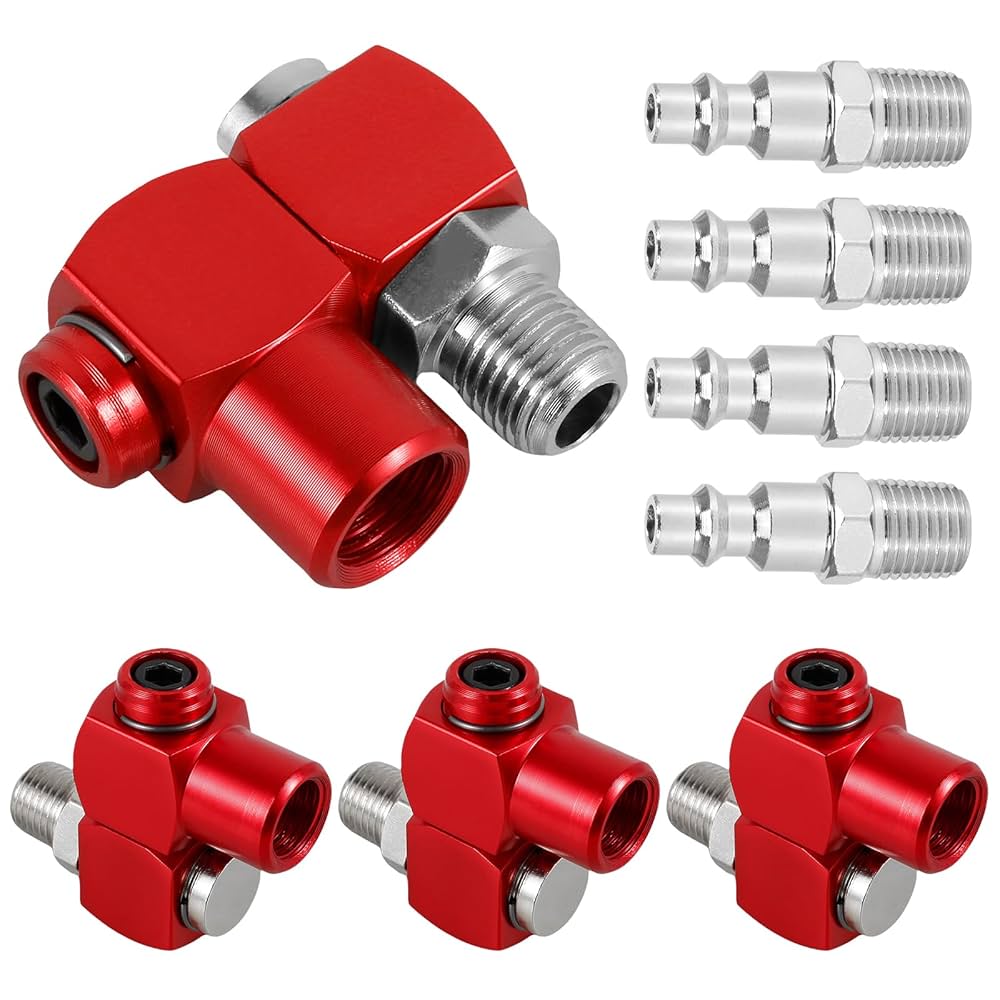If you rely on an air compressor for your projects, you know how important every part is—especially the hose fittings. These small connectors might seem simple, but they play a huge role in keeping your tools running smoothly and safely.
Choosing the right air compressor hose fittings can save you time, prevent leaks, and boost your overall efficiency. You’ll discover what makes a fitting the best choice for your needs, how to spot quality, and tips to avoid costly mistakes.
Keep reading to get the insider knowledge that will make your next project easier and more reliable.
Types Of Air Compressor Hose Fittings
Air compressor hose fittings join hoses to tools and machines. They keep the air sealed and safe. Different tasks need different fittings. Choosing the right type helps the air flow well. It also stops leaks and saves time.
Quick-connect Couplers
Quick-connect couplers attach and detach fast. They snap on with little effort. These fittings save time during tool changes. No need for twisting or screwing. They work well for jobs needing fast swaps.
Threaded Fittings
Threaded fittings screw into place tightly. They create a strong, secure connection. These fittings resist air leaks well. They suit fixed setups and heavy use. A wrench usually tightens them firmly.
Push-to-connect Fittings
Push-to-connect fittings lock hoses by pushing in. They hold tight without tools. Easy to use for quick setups. These fittings suit light to medium jobs. Removing them is simple and fast.
Barbed Fittings
Barbed fittings have ridges that grip inside the hose. They hold the hose firmly in place. Used with clamps for extra security. Good for flexible hoses and low pressure. They offer a simple, reliable fit.

Credit: www.princessauto.com
Materials Used For Fittings
Air compressor hose fittings connect hoses to tools and machines. Choosing the right material affects durability and performance. Different materials suit different tasks and environments. Understanding these materials helps pick the best fitting for your needs.
Brass Fittings
Brass fittings resist corrosion well. They last long in moist or wet conditions. Brass is soft, so it seals tightly and prevents leaks. These fittings handle high pressure and heat. They work well for many air compressor uses.
Steel Fittings
Steel fittings are very strong and tough. They resist damage from impact and wear. Steel works well in heavy-duty jobs. It handles high pressure better than many other materials. Steel fittings may rust if not coated.
Aluminum Fittings
Aluminum fittings are light and easy to handle. They do not rust like steel. Aluminum is less strong but good for low to medium pressure. These fittings help reduce overall hose weight. They suit portable and small air compressors.
Plastic Fittings
Plastic fittings are lightweight and cheap. They resist corrosion and many chemicals. Plastic is not as strong as metal fittings. These work best for low-pressure or occasional use. Plastic fittings break more easily than metal ones.
Choosing The Right Fitting Size
Choosing the right fitting size for your air compressor hose is key for safe and efficient operation. A fitting that is too small or too large can cause leaks or damage. Proper sizing ensures a tight connection and smooth airflow. This section breaks down the steps to select the correct fitting size.
Measuring Hose Diameter
First, measure the hose diameter accurately. Use a ruler or caliper to find the outside diameter of the hose. The size should match the fitting’s inner diameter. Precise measurement avoids loose or tight fittings. Check the hose end where the fitting will attach.
Matching Thread Sizes
Thread size compatibility is critical. Identify the thread type on both the hose and fitting. Threads come in different standards, such as NPT or BSP. Mismatched threads cause poor sealing and leaks. Confirm thread pitch and diameter before purchase.
Standard Size Charts
Use standard size charts for quick reference. These charts list common hose diameters and corresponding fitting sizes. Charts also help compare thread types and sizes. Keep a size chart handy when buying fittings. It reduces guesswork and ensures the right fit.

Credit: miltonindustries.com
Common Thread Types
Air compressor hose fittings use different thread types to connect parts securely. Choosing the right thread type is key to a tight, leak-free fit. Threads must match to avoid damage and air leaks. Three common thread types are widely used in air compressor systems.
Npt Threads
NPT stands for National Pipe Thread. It is a tapered thread used mainly in the United States. The taper helps create a tight seal as the threads are screwed together. NPT threads are popular for air hoses because they prevent air leaks effectively. They have a slight angle that makes the connection stronger under pressure.
Bsp Threads
BSP means British Standard Pipe. It is common in Europe and other countries outside the U.S. BSP threads come in two types: parallel (BSPP) and tapered (BSPT). Tapered BSP threads seal tightly like NPT, while parallel BSP threads need a sealing washer. BSP fittings work well with many air compressor hoses and tools.
Metric Threads
Metric threads use millimeters to measure thread size and pitch. They are common in Asia and some European countries. Metric threads are straight, not tapered. They often require an O-ring or washer to seal properly. Metric fittings fit specific air compressor models and tools designed for this thread type.
Installation Tips For Secure Connections
Securing air compressor hose fittings properly is essential for safe and efficient operation. Loose or leaking connections reduce performance and cause safety risks. Follow these simple installation tips to ensure a tight and lasting fit.
Using Thread Sealants
Thread sealants help prevent air leaks in threaded connections. Apply a small amount of thread sealant or Teflon tape to the male threads. Wrap the tape clockwise to match the thread direction. Avoid using too much sealant as it can clog the hose or damage fittings.
Proper Tightening Techniques
Hand-tighten the fitting first to align threads correctly. Use a wrench to tighten further, but do not over-tighten. Over-tightening can strip threads or crack fittings. Tighten just enough to stop leaks and ensure a firm connection.
Avoiding Cross-threading
Cross-threading damages threads and causes leaks. Start threading the fitting slowly by hand. If you feel resistance, stop and realign. Never force fittings together. Proper alignment protects your equipment and ensures a secure seal.

Credit: www.amazon.ca
Maintaining Air Compressor Hose Fittings
Maintaining air compressor hose fittings is essential for safe and efficient operation. Proper care helps avoid leaks and keeps air pressure steady. It also extends the life of your equipment.
Neglecting fittings can cause damage and reduce performance. Simple maintenance tasks can prevent costly repairs and downtime. Follow these steps to keep your hose fittings in good shape.
Regular Inspections
Check hose fittings often for signs of wear or damage. Look for cracks, corrosion, or loose connections. Tighten fittings if needed to stop air leaks. Early detection avoids bigger problems later.
Cleaning And Lubrication
Clean fittings with a dry cloth to remove dirt and debris. Avoid using water, which can cause rust. Apply a light lubricant to moving parts to keep them smooth. Clean fittings work better and last longer.
Replacing Worn Components
Replace fittings that show cracks or severe wear. Use parts that match your hose specifications. Old or damaged components can cause leaks and safety issues. Timely replacement ensures reliable performance and safety.
Troubleshooting Common Issues
Troubleshooting common issues with air compressor hose fittings helps keep your tools running smoothly. Problems like leaks and pressure loss reduce efficiency and can cause damage. Identifying and fixing these issues early saves time and money.
Leaks And How To Fix Them
Leaks happen when fittings are loose or damaged. Check all connections regularly for air escaping. Tighten loose fittings using the correct wrench. Replace worn or cracked fittings immediately. Use thread seal tape on threaded connections to ensure a tight seal. Small leaks waste air and reduce compressor power.
Fitting Compatibility Problems
Using the wrong fittings causes poor connections and leaks. Match the fitting size to the hose diameter exactly. Check the type of fitting, such as quick-connect or threaded. Avoid mixing brands to prevent mismatches. Proper compatibility ensures a secure, leak-free connection every time.
Preventing Air Pressure Loss
Air pressure loss lowers tool performance and slows work. Keep hose fittings clean and free from dirt or debris. Inspect hoses for cracks or holes and replace if needed. Use fittings designed for your compressor’s pressure rating. Regular maintenance prevents pressure drops and keeps air flow steady.
Upgrading And Customizing Fittings
Upgrading and customizing air compressor hose fittings can improve your tool’s performance and durability. Choosing the right fittings helps reduce air leaks and boosts efficiency. Tailoring fittings to your needs ensures smooth operation and long-lasting connections.
High-performance Fittings
High-performance fittings are made from strong materials like brass or stainless steel. These fittings handle high pressure and resist corrosion. They keep air flowing smoothly without leaks. Using them means fewer breakdowns and less maintenance. They fit tightly and hold up in tough jobs.
Specialty Fittings For Specific Applications
Specialty fittings serve unique tasks and environments. Some fit small spaces or unusual hose sizes. Others connect different hose types or tools. Certain fittings work well with chemicals or extreme temperatures. Selecting the right specialty fitting improves safety and job quality. It also saves time by preventing tool mismatches.
Frequently Asked Questions
What Are Air Compressor Hose Fittings Used For?
Air compressor hose fittings connect hoses to compressors and tools. They ensure airtight seals and efficient airflow. Proper fittings prevent leaks and maintain system pressure. They come in various sizes and materials for different applications. Choosing the right fitting improves tool performance and safety.
How To Choose The Right Air Compressor Hose Fittings?
Select fittings based on hose size, thread type, and material compatibility. Consider pressure rating and durability for your application. Brass fittings resist corrosion, while steel offers strength. Ensure fittings match your compressor and tools to avoid leaks. Proper choice enhances efficiency and lifespan of equipment.
Can I Use Universal Air Compressor Hose Fittings?
Universal fittings may work with many tools but can cause leaks. They often lack precise sizing, leading to poor seals. It’s better to use manufacturer-recommended fittings for optimal performance. Using correct fittings ensures safety and maintains compressor efficiency. Avoid universal fittings in high-pressure systems.
How To Maintain Air Compressor Hose Fittings?
Regularly inspect fittings for wear, cracks, or corrosion. Clean connections to remove dirt and debris. Tighten loose fittings to prevent air leaks. Replace damaged or worn fittings promptly. Proper maintenance extends hose life and ensures reliable compressor performance.
Conclusion
Choosing the right air compressor hose fittings ensures safe and efficient work. Good fittings prevent leaks and keep air pressure steady. Check materials and sizes before buying to fit your needs. Proper installation helps tools run smoothly without interruption. Regular inspection avoids damage and costly repairs.
Simple steps lead to better performance and longer hose life. Keep your workspace safe and productive with quality fittings. This small part makes a big difference in your air compressor system.

